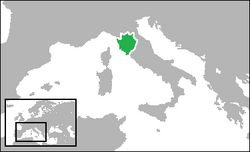
Back Republica de Florencia AN جمهورية فلورنسا Arabic República de Florencia AST Florensiya Respublikası Azerbaijani فلورانس جومهوریتی AZB Фларэнтыйская рэспубліка Byelorussian Флорентинска република Bulgarian Republik Firenze Breton República de Florència Catalan کۆماری فلۆرانسا CKB
Republic of Florence Res publica Florentina (Latin) | |||||||||||||||||
|---|---|---|---|---|---|---|---|---|---|---|---|---|---|---|---|---|---|
| 1115–1569 | |||||||||||||||||
 The Florentine Republic in 1548 | |||||||||||||||||
| Capital | Florence 43°46′10″N 11°15′22″E / 43.76944°N 11.25611°E | ||||||||||||||||
| Common languages | Latin Italian | ||||||||||||||||
| Religion | Roman Catholicism | ||||||||||||||||
| Demonym(s) | Florentine | ||||||||||||||||
| Government | Oligarchic republic (1115–1494; 1498–1532) Republic under a theocratic regime (1494–98) | ||||||||||||||||
| Gonfaloniere of Justice | |||||||||||||||||
• 1293–1295 | Giano della Bella (first) | ||||||||||||||||
• 1434–1464 | Cosimo de' Medici (first de facto Lord of Florence) | ||||||||||||||||
• 1530–1532 | Alessandro de' Medici (last) | ||||||||||||||||
| Duke of the Florentine Republic | |||||||||||||||||
• 1532–1537 | Alessandro | ||||||||||||||||
• 1537–1569 | Cosimo I | ||||||||||||||||
| Legislature | Priorato delle Arti | ||||||||||||||||
| Council of Ancients | |||||||||||||||||
| Council of Consuls | |||||||||||||||||
| History | |||||||||||||||||
• First established | 1115 | ||||||||||||||||
• Marquisate restored by Imperial force | 1185–1197 | ||||||||||||||||
| 1378 | |||||||||||||||||
• Incorporation of Pisa | 1406 | ||||||||||||||||
• Founding of the House of Medici | 1434 | ||||||||||||||||
• Title of Duke of the Florentine Republic created | 1532 | ||||||||||||||||
• Occupation of Siena | 1555 | ||||||||||||||||
• Elevated to Grand Duchy of Tuscany | 1569 | ||||||||||||||||
| Currency | Florin (from 1252) | ||||||||||||||||
| |||||||||||||||||
| Today part of | Italy | ||||||||||||||||
The Republic of Florence (Latin: Res publica Florentina; Old Italian: Republica di Fiorenza), known officially as the Florentine Republic, was a medieval and early modern state that was centered on the Italian city of Florence in Tuscany, Italy.[1][2] The republic originated in 1115, when the Florentine people rebelled against the Margraviate of Tuscany upon the death of Matilda of Tuscany, who controlled vast territories that included Florence. The Florentines formed a commune in his successors' place.[3] The republic was ruled by a council known as the Signoria of Florence. The signoria was chosen by the gonfaloniere (titular ruler of the city), who was elected every two months by Florentine guild members.
During the Republic's history, Florence was an important cultural, economic, political and artistic force in Europe. Its coin, the florin, was the dominant trade coin of Western Europe for large scale transactions and became widely imitated throughout the continent.[4][5] During the Republican period, Florence was also the birthplace of the Renaissance, which is considered a fervent period of European cultural, artistic, political and economic "rebirth".[6]
The republic had a checkered history of coups and countercoups against various factions. The Medici faction gained governance of the city in 1434 under Cosimo de' Medici. The Medici kept control of Florence until 1494. Giovanni de' Medici, who later became Pope Leo X, reconquered the republic in 1512.
Florence repudiated Medici authority for a second time in 1527, during the War of the League of Cognac. The Medici reassumed their rule in 1531 after an 11-month siege of the city, aided by Emperor Charles V.[7] Pope Clement VII, himself a Medici, appointed his relative Alessandro de' Medici as the first "Duke of the Florentine Republic", thereby transforming the Republic into a hereditary monarchy.[7][8]
The second duke, Cosimo I, established a strong Florentine navy and expanded his territory, conquering Siena. In 1569, the pope declared Cosimo the first grand duke of Tuscany. The Medici ruled the Grand Duchy of Tuscany until 1737.
- ^ Brucker, Gene A. (1998). Florence: The Golden Age 1138–1737. University of California Press. ISBN 0-520-21522-2.
- ^ Najemy (2006).
- ^ "History of Florence". Aboutflorence.com. Archived from the original on 1 August 2020. Retrieved 26 May 2009.
- ^ "Florence – Climate". Encyclopædia Britannica. Archived from the original on 17 April 2015. Retrieved 19 October 2021.
- ^ "Fiorino". Retrieved 15 March 2023.
- ^ "Renaissance". History.com. Archived from the original on 19 October 2021. Retrieved 19 October 2021.
- ^ a b Goudriaan (2018), pp. 8–9.
- ^ Strathern (2007), p. 321.



